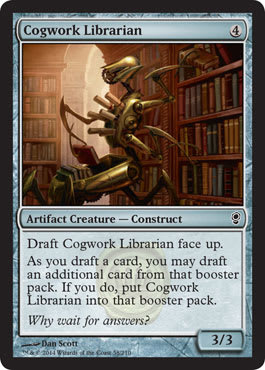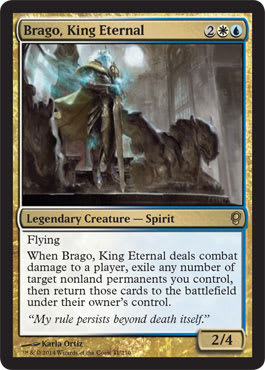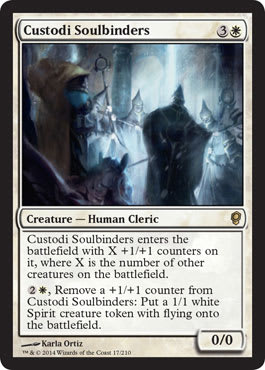At least, in many corners that that been a common consensus. They’re junk decks, filled with draft trash, and they offer nothing useful to the new player. In the wake of the forthcoming Planeswalker Decks, good riddance!
I'll be the first to admit that these much-maligned but necessary products do have something of an image problem. Some of this, though, stems from who’s doing the perceiving. Most people online adding their opinions to the collected social media hive mind are, unsurprisingly, players who have more of an emotional investment and attachment to the game. These also happen not to be the people for whom the Intro Pack is (largely) intended. If you’re talking about “EV” when it comes to introductory-level products, you’re probably not the intended audience.
Today, however, I’d like to look at the issue from the other side. This isn’t a spirited defense of the value and role of the humble Intro Pack, I already did that. Rather, to walk through the creation of an Intro Pack and see what sort of considerations go into it. I expect we’ll find the process is a little bit more involved than “wrap up a bunch of draft chaff, drop in two bulk rares, slap two boosters on it and on you go.”
For my Intro Pack, I wanted to select a set that didn’t have Intro Packs released alongside it, so I could begin without expectations and with a clean slate. I considered Eternal Masters, since it’s timely, but dismissed that because it’s a pushed set with some very baked-in color-pair strategies. Same with Modern Masters (both sets). To be fair, anything I chose would be a little different from the ordinary, because the ‘ordinary’ would have had its own Intro Pack decks. Ultimately, I settled on Conspiracy.
Why Conspiracy? I kept coming back to Mark Rosewater’s famous axiom, “restrictions breed creativity.” This wasn’t just a drafting set, it was a meta drafting set, with lots of self-referential cards like Cogwork Librarian and Deal Broker. I’d have to exclude those cards and work with what was remaining. Plus, it has a more modest power level, so it would more closely resemble what you see in ordinary Intro Packs.
For this exercise, I arbitrarily chose U/W. This is a very common archetype, and will generally have a number of themes common across all sets. First, you’ll often see a lot of flying creatures, or ones that are evasive in some way. This isn’t a Green deck that wants to climb over the top of you, but rather one that prefers to avoid that messy blocking thing altogether where it can help it.
Speaking of blocking, it’s nevertheless more than happy to do its fair share of it. Both colors happily run creatures with low power and high toughness, to congest the red zone and prevent an opponent from running away with the game. This often means the U/W deck needs a little time to set up, so it stalls the board out. This synergizes well with a Skies strategy, too, since denying your opponent profitable attacks while making yours hard to stop is a time-honored tactic.
When it comes to spells, you can count on a good amount of removal, from traditional Blue tempo plays like Unsummon to White’s often combat-related instants or more broad-based enchantments. White also likes its combat tricks, while Blue usually has a dash of countermagic.
But the card that often brings the deck together and sets the tone is the one that’s selected for the premium rare foil card, the one that will be on the front of the packaging, and it’s almost always a creature. With that in mind, we have the following options:
- Academy Elite
- Brago, King Eternal
- Custodi Soulbinders
- Pristine Angel
- Reya Dawnbringer
- Wakestone Gargoyle
Academy Elite
This would work great in an instants/sorceries deck, but those tend to be best suited for a pairing with Red, not White. Red tends to have “spells matter” cards just like Blue does, as often these decks need more than just a bunch of spells to gain battlefield advantage.
Brago, King Eternal
Brago checks off a lot of boxes. He’s a legend, for one, and folks do love foil legends (especially if we went the alternate art route). He has a flashy effect, too, one that would be well-suited if we have recourse to a number of creatures with enters-the-battlefield (ETB) effects. A definite possibility.
Custodi Soulbinders
This is an interesting card, but unless we were rocking tribal Spirits it probably wouldn’t be splashy or thematic enough to be our premium rare. That said, Intro Packs have a few things in common with Duel Decks, in that both like to have card diversity as well as “occasional interactions” between cards that let players feel clever when they make the connection. The Soulbinders might not be great for the top job, but they might be a good fit for the runner-up if we go with Brago, thanks to the synergy between the two.
Pristine Angel
This is a fine choice, nice and splashy, and difficult for an opponent to deal with. Sure it’s a reprint, but it wouldn’t be the first reprint to get the Intro Pack foiling treatment.
Reya Dawnbringer
Another splashy card with a great effect, pulling creatures back to life, but that mana cost means most of the time it’ll just be camping out in your hand. There’s also a flavor angle here, as the Conspiracy set has a large number of reprints that don’t necessarily convey anything about Fiora, the plane Conspiracy is set in. Reya, a reprint from Invasion, fits that bill.
So it looks like it’s down to a choice between Brago, King Eternal and Pristine Angel. I’m leaning toward Brago, but it’s also going to depend on what we have to work with in the set. The Brago-Soulbinders combo is cute, but if there aren’t a lot of ETB creatures in White and Blue, it’s just not going to do enough on its own.
So let’s make some lists! We’ll start with a list of all the Blue and White common and uncommon creatures with ETB effects.
Now, you know that whole “restrictions breed creativity” thing? Here’s where we have to get creative, because unlike with a normal Constructed deck, the idea here isn’t simply to “be good.” Right now we have a list of rares to consider, and some cards that might work well with one of them (Brago). Let’s step back for a moment and consider the things we have to take into account.
Rarity distribution
An average rarity distribution gives us some framework as to what cards we’re to select. It does us no good to build a deck filled with uncommon cards no matter how fun the final result, because that’s not how an Intro Pack is composed. We’re going to have a quota of 2 rare cards, 12 uncommon cards, and 22 commons.
Land content
Painful as it may be, we’ll be observing the modern convention of a slightly richer land mix. This is presumably because Wizards understands mana flood is generally less frustrating for players than mana screw, because at least with flood you get to do something, even if the outcome is usually the same (losing). It’s also one of the “nudge points” in Intro Packs that guides nascent deck-builders to develop the skills they’ll need to enjoy the rich fullness of the game. Play enough times, and at some point our new player is going to ask themselves if they can cut down on land a little and improve their deck’s play overall. Eureka!
Mechanical identity
Having a theme or mechanical identity for the deck is important. Take, for example, the five Intro Pack decks of Shadows over Innistrad. They’re not vague, amorphous collections of card. They’re trying to do something in line with the innovations of the set they represent. Ghostly Tide focuses on Spirits and flying, while Unearthed Secrets explores the investigate mechanic and things you can do with Clue tokens. Vampiric Thirst is a nice double-dip of Vampire tribal and madness, while Horrific Visions showcases delirium. Finally, Angelic Furyis . . . well . . . the exception that proves the rule, perhaps. It’s W/R midrange agro, but doesn’t highlight much more than that.
For our deck, we’ll want to make sure that we’re taking advantage of the different things Conspiracy has to offer. Now go back to that ETB list for a closer look. The Council Guardian and Custodi Squire both feature a Conspiracy mechanic, Will of the Council, so that’s a plus. Designed for multiplayer, it’s a little clunky and inelegant in a two-player duel (“yay, another tie!”), but it’s not a stretch to think that Conspiracy Intro Packs could have been marketed for multiplayer use.
With Brago able to flicker them, the Guardian could change the color of its protection to better adjust to battlefield conditions, while the Custodi Squire can return cards from the graveyard. That’s very synergistic, and a nice reward for getting both into play at the same time. On the other hand, it forces us to run a mix of artifacts and enchantments in our deck to make sure there are at least opportunities for those things to wind up in a player’s graveyard. While the set contains a lot of artifact creatures, most of them impact the Conspiracy draft, which you skip when you buy an Intro Pack.
The Glimmerpoint Stag flickers another permanent until the end of turn, which can be a nice play to remove a particularly nettlesome blocker, except that by the time Brago’s effect triggers, we’re already well into the combat phase. The Peace Strider is an excellent card for a Brago-based deck, as learning players often appreciate lifegain more than established ones do. Finally, the Screaming Seahawk goes and fetches another Screaming Seahawk. That’s not especially helpful, since it’s likely a one-time effect. Once they cast the next Seahawk, they’ll tutor up the third and final one (Intro Packs, remember, typically max out at three copies of a card). After that . . . pfft.
So if you’re thinking at this point that the Brago-Flicker Express has a pretty short track, you’re not alone. Going over the U/W card list, though, there is a lot of support for a Skies strategy. That’s not surprising, since this is a pretty common archetype for this color combination. Both of the rares we’re looking at here, Brago and the Angel, have flying, so this still keeps them both in the frame.
So to recap, here’s where we are with our Conspiracy Intro Pack.
Colors: U/W
Deck theme: Skies, some Conspiracy mechanics preferred
Premium rare: Brago, King Eternal or Pristine Angel
That’s a solid start. We’ll finish out our deck next week.
Any ideas?































